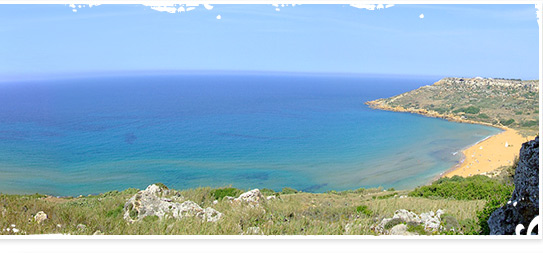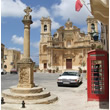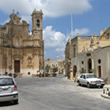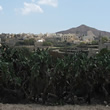Bus Route: From Victoria - Bus No.2,
91 |
Gharb is one of the oldest Gozitan
villages, where various archaeological
excavations exposed the remains of Neolithic and Bronze Age settlements
in the area. The name Gharb is purely Arabic, denoting the establishment
of an early but organised community during Arab domination between
870 and 1090 AD. However, names of early Christian devotion such
as St. Demetrius and St.Publius, indicate that pre-Arab Roman and
Byzantine settlements existed before this westerly village took
its present name.
There are no significant historical episodes related with Gharb.
However the people of this village with their coastal lookouts,
have the merit of being the first to signal the arrival of reinforcements
to the beleaguered Maltese under the Knights of St. John in the
Great Siege of Malta of 1565. During those terrible years, the Gharb
lookouts constantly relayed smoke signals to Malta, alarming the
entire population from the constant perils of marauding Berber and
Turkish pirates.
The feast
day is on the 31st May of every year and the outside festivities
are held on the first weekend of July. The village of Gharb has
other churches
and chapels that intertwine
in traditional legends and religious devotion.
The most popular Shrine on Gozo, the one dedicated to Our Lady of
Ta' Pinu also lies within the perimeter of Gharb. This architectural
masterpiece was built next to an old chapel (still existing), where
it is profoundly believed that back in 1883, Our Lady has spoken
to a devotee from Gharb named Karmni Grima. Ta' Pinu Sanctuary is
a place of great devotion and is of national importance. Numerous
pilgrims, both locals and tourists visit Ta' Pinu Shrine all year
round. The main painting of the church depicts the Assumption to
the Heavens of Our Lady, and is the same painting that was enshrined
in the old medieval chapel.
Gharb also offers the visitor a modest number of curious museums.
Two of these museums where the restored residences of two of the
saintly sons of the village, namely Karmni
Grima who started the Ta' Pinu devotion, and that of Frenc Mercieca,
popularly known as Frenc ta' l-Gharb. Frenc ta' l-Gharb was a wise
but rather humble saintly man who lived between 1892 and 1967. He
had a distinct ability to cure a lot of people leaving several doctors
of the day perplexed by his successes. He combined his old knowledge
in old medicinal herbs, his prayers and his faith in Our Lady for
his cures, and his reputation spread rapidly throughout the entire
Maltese Islands and even abroad. The Gharb Folklore Museum (found
at Pjazza Zjara tal-Madonna) is a private owned museum found in
the core of the village. Its 28 rooms are full of all kind of antique
tools and artifacts. It is really worth visiting.
Another attraction of the village of Gharb is the Ta' Dbiegi Crafts
Village, where various handcrafts are made and sold. Visitors can
find hand-made pottery, mouth-blown glass, Gozo lace and filigree.
Gharb is the place where glass blowing and pottery could be watched
being made.
With all the above attractions, Gharb is the village that the visitor
to Gozo should not miss. Its panoramic countryside tracks and valleys
are ideal for walks
and for relaxing. If one is not interested in museums, a walk to
the cliffs at Wied il-Mielah, is worth every second spent. There,
a spectacular natural "window", not as exploited, but
similar to the Azure Window of Dwejra
is found. Otherwise one could opt to sit relaxed in the peaceful
and picturesque village square, enjoying the view of the church,
the lethargic strokes of its clock tower, or curiously study the
unique shape of old hand sculptured balconies that adorn the village's
oldest homes.
|
|












